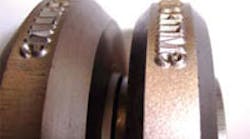Smith & Wesson switched to engraved roll marking dies to replace marking dies made by the EDM process to improve the life of its stamping tools and to ensure that the marks it makes on its weapons are consistent and clear.
Marking a component or a part with a steel stamp is basically a cold forging process. The material is being moved around or compressed. For a stamp to be durable and effective in producing a clear mark, it must be hard, it must have sharp edges and it must have a smooth surface along the entire relief of the character.
Tom Phipps, chief executive officer of Columbia Marking Tools, said engraved stamps used in marking typically last twice as long, and in some instances up to eight times as long, as stamps made by the EDM process.
Phipps said the EDM process involves intense local heating that changes the metallurgy at the surface of the stamp characters and the subsurface of the stamp to a depth of 0.005-in (0.13 mm).
Because that typically is done after heat treat, Phipps said stamping die life can be reduced as much as four times by the EDM process.
“Engraving or the use of Pantograph engraving machines to produce stamps and hand stamps is not just about the high speed milling technology we use to provide a sharp and smooth cutting edge, it’s about machining skill and know-how,” Phipps said.
Phipps said that his company employs three of the seven master stamp engravers in the world.
The tracing Pantograph engraving machines use a font pattern that is six times the size of the final product. That proportionally reduces errors. Phipps said his company has a preventative maintenance and rebuilding program in place necessary to keep these precision machines at their peak accuracy.
The engraving cutters are sharpened every sixth engraving, and each engraving involves passes for rough, semi-finish and micro-finishing.
After Pantograph processing, the characters are polished, buffed and inspected.
There are two different types of engraved stamps: those with standard fonts, and those with special fonts or company logos.
Columbia Marking Tools typically produces and ships standard fonts in one day to four days, and special designs within 2 weeks, depending on the expediency of the engineering approval and drawing process.
The company uses AutoCAD and Solidworks software to reduce its turn-around times.
Phipps said that one of the keys to having a stamp work correctly while providing good wear life is having a good understanding of the metallurgy of the material that is being marked. That knowledge leads to the selection of the proper tool steel or high-speed-steel for the stamp.
Once that is determined, the stamp prints and processes are released to the factory for production on the hybrid Pantograph machines where the font pattern is engraved.
“Because steel marking stamps are considered secondary operation tools, it’s not uncommon to find stamps operating for up to six months without being replaced. Combine this situation with the increased use of more environmentally friendly water-soluble lubricants and release agents and you’ll find compacted dirt in the character grooves, and rust becomes another tool life factor,” Phipps said.
For that reason, Columbia Marking Tools developed a proprietary coating — its ACC Auto Clean —to provide the lubricity while preventing dirt from compacting in the individual stamp characters and to inhibit rust while the stamps are on inventory shelves.
The company said the coating is an improvement over black oxide coatings and chrome plating, and does not add cost to its stamps.
Columbia Marking Tools designs and manufactures metal and plastic marking equipment including stamps, roll marking dies, roll marking and impact marking machines, fully programmable pulsed fiber diode laser, peen/scribe marking and UID/2D Square Dot machines, numbering heads and special marking machines.







